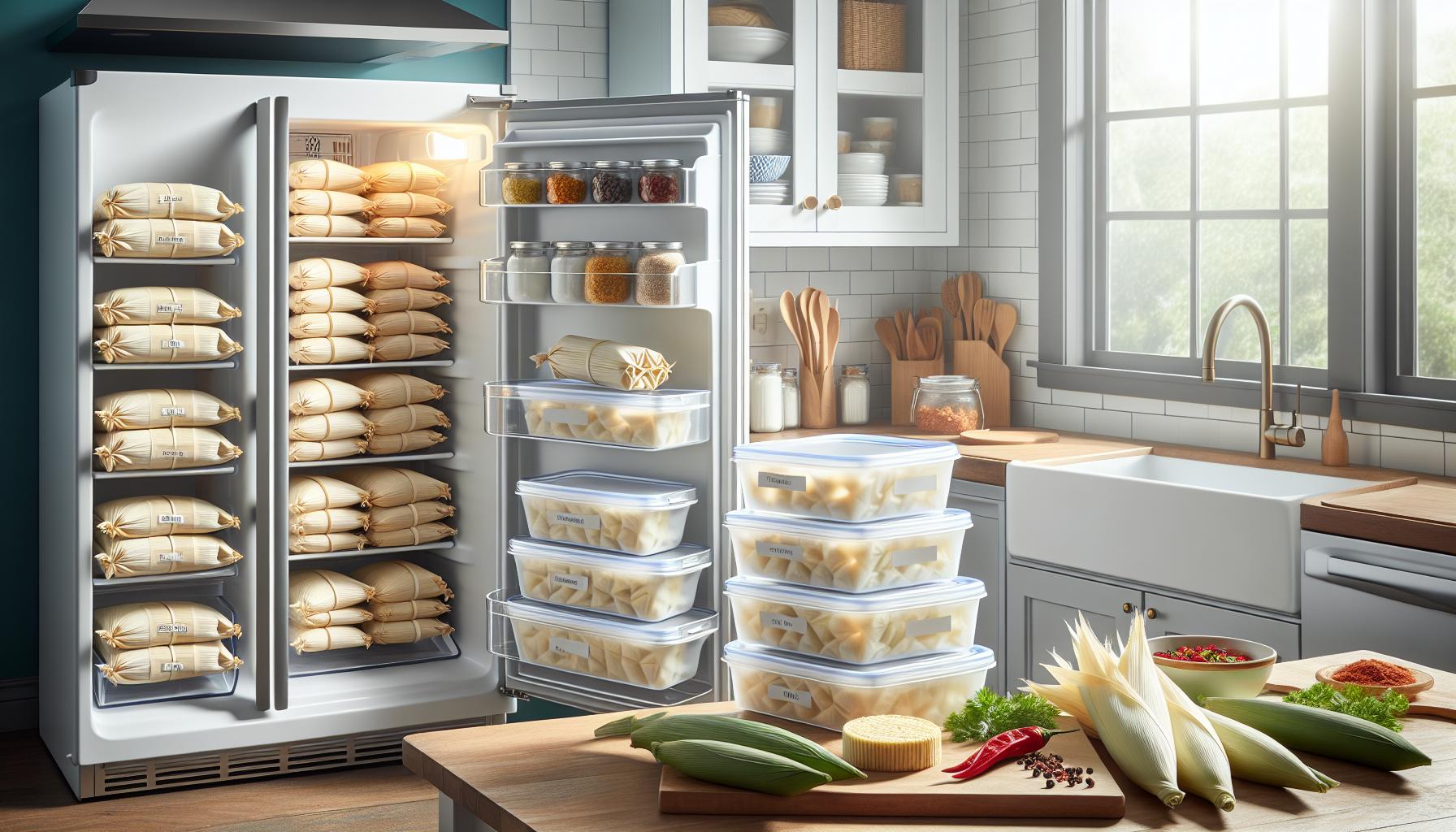Tamales, with their savory fillings and comforting masa, are a beloved dish that can bring the flavors of tradition right to your kitchen. If you’ve ever made a big batch to freeze for later, you might wonder how long they last without losing their deliciousness. Properly storing tamales not only helps to preserve their flavor and texture but also ensures you can enjoy them safely over time.
Understanding how to freeze and store tamales correctly can save you from waste and provide you with quick, satisfying meals later on. Whether you’re a tamale enthusiast or just looking to make your cooking efforts last, knowing the right freezer duration and storage tips is essential. Dive in to discover how long tamales will stay delicious in the freezer and learn best practices for keeping them fresh, so you can savor these delightful treats whenever the craving strikes.
How Long Can You Freeze Tamales Safely?
Tamales are a delicious and versatile dish, often made in large batches; freezing is a great way to preserve their flavor and texture for later enjoyment. When it comes to freezing tamales, safety and quality are top priorities. Tamales can safely be frozen for up to three to six months when properly stored. Although they may still be edible beyond this timeframe, the quality, taste, and texture may significantly diminish after the six-month mark.
To ensure the best results, it’s essential to consider how you prepare and store them before freezing. First, allow cooked tamales to cool completely at room temperature. This practice helps prevent moisture buildup, which can lead to freezer burn. Next, wrap each tamale securely in plastic wrap or aluminum foil, and then place them in an airtight container or a heavy-duty freezer bag. Label the containers with the date of freezing, making it easy to track storage times. Keeping tamales in smaller portions can also facilitate easier reheating and minimize waste.
Ultimately, keeping track of your frozen tamales not only ensures optimal taste and safety but also allows you to enjoy freshly reheated tamales that taste almost as good as when they were first made. Following these guidelines will help you savor the delicious flavors of tamales long after they are prepared.
Optimal Freezing Techniques for Tamales
To preserve the delightful taste and texture of tamales, mastering optimal freezing techniques is essential. Properly freezing tamales not only extends their shelf life but also helps retain their delicious flavors. The first step in achieving this is to ensure that your cooked tamales are completely cooled to room temperature before freezing. This prevents the accumulation of moisture, which can lead to freezer burn-a common enemy in the freezing game that compromises quality.
Once cooled, it’s advisable to wrap each tamale tightly in plastic wrap or aluminum foil. This protective layer is crucial as it minimizes exposure to the air, further safeguarding against freezer burn. For added protection, place the wrapped tamales in an airtight container or heavy-duty freezer bag. If you’re using freezer bags, be sure to squeeze out as much air as possible before sealing. Additionally, labeling each container with the date ensures that you’ll be able to keep track of how long they have been stored.
Storing tamales in smaller batches can be a game-changer; it not only makes reheating easier but also allows you to only thaw what you need, minimizing waste. Tamales can be safely stored in the freezer for up to three to six months without significant loss of flavor or texture. To help keep your tamales fresh and flavorful, consider adding a vacuum sealer to your toolkit. These devices extract air from packaging and seal it tightly, creating an ideal environment for preserving food in the freezer. Following these techniques will ensure that your tamales stay delicious, ready to be enjoyed whenever the craving strikes.
How to Store Tamales for Longevity
To ensure your tamales maintain their delicious flavor and delightful texture for as long as possible, understanding how to store them properly is vital. The ideal storage method involves not only the right wrapping techniques but also suitable containers that keep air, moisture, and temperature fluctuations at bay.
First, make sure your tamales have cooled completely to room temperature after cooking. Place each tamale in an individual protective layer, such as plastic wrap or aluminum foil. This prevents exposure to air, which can lead to freezer burn. Next, group several wrapped tamales into airtight containers or heavy-duty freezer bags. If using freezer bags, remember to expel as much air as possible before sealing to further reduce the chances of freezer burn. Label each container with the date, allowing you to track their storage time.
Tamales can be stored safely in the freezer for three to six months without significant loss of quality. For optimal longevity, consider using a vacuum sealer; it effectively removes air from packaging, creating a sealed environment that preserves freshness. Keeping tamales grouped in smaller batches is also advantageous, as it allows for easier reheating and minimizes waste by enabling you to thaw only what you need at a time.
In summary, proper storage practices play a critical role in preserving the quality of your tamales. By following these steps-cooling, wrapping, sealing, and labeling-you can enjoy tasty tamales well beyond their initial preparation.
Signs Your Frozen Tamales Are Spoiled
To enjoy tamales at their best, it’s essential to recognize the signs that indicate your frozen treats may have gone bad. There’s nothing worse than unwrapping a tamale, only to find that it has lost its character due to spoilage. While freezing can significantly extend the lifespan of your tamales, they are not immune to deterioration over time.
One of the first signs of spoilage is a noticeable change in appearance. Look for any discoloration, such as browning or grayish hues, which can signal that the tamales are no longer fresh. If you notice ice crystals forming within the packaging, this may indicate freezer burn, which not only alters the texture but can also impart a stale flavor. Additionally, if the tamales emit an off or sour smell when unwrapped, it’s a strong indicator that they should not be consumed.
Checking the texture can also provide clues about the condition of your frozen tamales. They should remain firm and moist; if they feel excessively dry, crumbly, or mushy, they may have deteriorated. For peace of mind, it’s advisable to stick to the recommended freezing timeframe of three to six months. Beyond this period, the quality will likely decline, even with proper storage techniques.
A good rule of thumb is to trust your senses. If something seems amiss, it’s always safer to err on the side of caution. Enjoying tamales at their peak flavor means being vigilant about their condition-even in the freezer. When in doubt, throw them out to ensure your meal remains delicious and safe!
Reheating Tamales: Best Practices
Reheating tamales is an art that can bring your frozen delights back to life, ensuring they are as delicious and satisfying as the day they were made. The key to effective reheating is to prioritize moisture retention to avoid a dry or overly chewy texture. Here are some tried-and-true methods to revive your tamales:
###
Steaming: The Best Way to Reheat Tamales
The ideal method for reheating tamales is steaming, as it preserves their moisture and original texture. To do this:
- Fill a pot with a couple of inches of water and bring it to a boil.
- Place the tamales upright in a steamer basket or on a plate and cover them with a damp cloth or foil to maintain moisture.
- Steam the tamales for approximately 15-20 minutes if they are thawed, or 30-40 minutes if reheating directly from frozen. Check occasionally to ensure they’re heated through.
###
Microwaving: The Quick Option
If you’re short on time, microwaving can be a quick solution, though it might not yield the same authenticity in texture. Here’s how to do it safely:
- Wrap each tamale in a damp paper towel to keep them moist.
- Place them in the microwave and heat at medium power for 1-2 minutes for thawed tamales or 2-4 minutes for frozen ones.
- Check after each minute to avoid overheating, which can lead to dryness.
###
Oven Reheating: Perfect for Large Batches
For reheating larger quantities, the oven is a solid choice, providing an even heat that helps crisp the outer layer:
- Preheat your oven to 350°F (175°C).
- Wrap tamales in foil to maintain moisture and place them on a baking sheet.
- Bake for 20-30 minutes if thawed or 30-45 minutes if frozen, checking for a hot center.
Regardless of the method you choose, keep in mind that tamales should reach an internal temperature of at least 165°F to ensure they are safely reheated and enjoyable. By taking the time to reheat them properly, you’ll enjoy tamales that taste fresh and flavorful, as though they’ve just been made.
Enhancing Flavor After Freezing Tamales
After tamales have been frozen, they may benefit from some enhancements to restore their original flavor and make them even more delicious. Freezing can sometimes dull the vibrant flavors, so a few simple steps can ensure they remain a delight on your palate.
One of the best ways to enhance flavor is to serve tamales with freshly made salsas or sauces. Consider whipping up a zesty tomatillo salsa or a rich mole sauce that can complement the fillings of your tamales. These fresh toppings not only add moisture but also invigorate the overall taste experience. Additionally, you can sprinkle fresh herbs like cilantro or green onions over the top for a burst of freshness.
Another effective method is to incorporate rich ingredients during the reheating process. For instance, drizzle a little warm chicken broth over the tamales before steaming or microwaving them to infuse moisture and flavor. If you’re reheating in the oven, consider adding a pat of butter or a splash of cream to achieve a creamier texture that elevates the taste.
If your tamales are packed with savory proteins like shredded pork or chicken, try adding a layer of cheese on top before reheating. As it melts, the cheese will enhance the richness of the tamales and create a deliciously gooey topping that is hard to resist. Don’t shy away from experimenting with different cheeses; cotija, Monterey Jack, or even a spicy pepper jack can create delightful flavor combinations that entice your taste buds.
Finally, consider serving sides that complement the tamales. A refreshing corn salad, guacamole, or pickled jalapeños can elevate the meal and provide a nice contrast to the heartiness of the tamales. By incorporating these elements, not only do you improve the taste of your frozen tamales, but you also transform them into a complete and satisfying meal that will impress your family and friends.
Storing Different Types of Tamales
When it comes to preserving the deliciousness of tamales, understanding how to store different types is essential. Each variety of tamale-whether it’s filled with meat, cheese, vegetables, or sweet fillings-has unique characteristics that can affect its storage requirements and lifespan in the freezer.
For savory tamales like the traditional pork or chicken varieties, they can typically be stored in the freezer for up to 6 months without significant loss of quality. It’s best to wrap each tamale individually in plastic wrap or aluminum foil before placing them in an airtight container or freezer bag. This minimizes exposure to air and prevents freezer burn. Ensure you label them with the date and type of filling for easy identification later.
If you’re dealing with sweet tamales, like those filled with chocolate or fruit, the freezing process is similar. However, it’s wise to consume sweet tamales within 3 to 4 months for optimal flavor. These tamales can also be wrapped individually, but make sure they are well-sealed to maintain their sweetness and texture. Additionally, consider placing wax paper between layers of sweet tamales in a container to avoid sticking.
Vegetarian tamales, filled with ingredients like cheese, beans, or vegetables, can be frozen for about 4 to 5 months. Pay special attention to how you package them; the moisture in vegetables can lead to quicker spoilage. Using freezer-safe containers that are also airtight is crucial to maintain their freshness, as they are more susceptible to freezer burn due to their moisture content.
- Savory Tamales: Up to 6 months in the freezer.
- Sweet Tamales: 3 to 4 months for best flavor.
- Vegetarian Tamales: 4 to 5 months without compromising quality.
Finally, always remember to thaw tamales in the refrigerator before reheating, which helps regain moisture lost during the freezing process. Keeping these guidelines in mind will ensure your tamales remain a delicious treat whenever you decide to enjoy them.
Tips for Avoiding Freeze Burn on Tamales
To keep your tamales tasting fresh and delightful after freezing, avoiding freezer burn is essential. Freezer burn occurs when moisture evaporates from food, leading to dry, flavorless patches. To combat this common issue, packaging is key. Wrap each tamale tightly in plastic wrap or aluminum foil before placing them in an airtight freezer bag or a well-sealed container. This minimizes air exposure, which helps preserve moisture and flavor.
When storing your tamales, be mindful of the order in which you place them in the freezer. Avoid stacking unwrapped tamales directly on top of each other; instead, use parchment or wax paper between layers to ensure airflow and protect against sticking. If you are freezing a large batch, try to ensure that they are arranged in a single layer during the initial freezing process until they are firm. Once solid, you can stack them without as much risk of freezer burn.
Temperature plays a pivotal role in preventing freezer burn as well. Ensure your freezer is operating at 0°F (-18°C) or lower, as this keeps the tamales frozen solid and minimizes the fluctuation that can cause moisture loss. Additionally, avoid frequent opening of the freezer door, which can allow warmer air in, thus increasing the risk of freezer burn over time.
If you notice any discolored areas or a dry texture when thawing your tamales, it’s a sign that freezer burn may have occurred. While these tamales are still safe to eat, their taste and texture might be compromised. To prevent this, use your tamales within the recommended freezing times based on their type-savory tamales up to 6 months, vegetarian for 4 to 5 months, and sweet varieties for about 3 to 4 months-for the best quality and flavor retention. Remember, careful preparation and proper storage techniques are your best defense against freezer burn, ensuring that your tamales retain their deliciousness for whenever you’re ready to enjoy them.
Common Mistakes in Freezing Tamales
Freezing tamales can be a great way to ensure that you always have a delicious meal on hand, but several common pitfalls can lead to disappointing results. One of the most frequent mistakes is improper wrapping. Tamales contain moisture, and if they are not tightly wrapped, they can develop freezer burn. This happens when air reaches the food, causing dehydration and loss of flavor. To avoid this, every tamale should be individually wrapped in plastic wrap or aluminum foil before being placed in an airtight freezer bag or container.
Another mistake is freezing tamales too late after they’ve been made. Ideally, tamales should be frozen within a couple of days to retain their flavor and texture. Allowing them to sit in the fridge for too long before freezing can lead to sourness or spoilage. Additionally, a common error is stacking unwrapped tamales on top of each other in the freezer, which can cause them to freeze unevenly or stick together. Instead, freeze them in a single layer until they’re firm before arranging them in a stack.
Temperature fluctuations in the freezer can dramatically affect the quality of frozen tamales. Regularly checking the freezer’s temperature is essential; keeping it at 0°F (-18°C) or lower will help maintain the integrity of your tamales. Frequent opening of the freezer can let warm air in, promoting spoilage. Finally, neglecting to label your freezer bags with dates can lead you to keep tamales far beyond their optimal freezing time. Remember, savory tamales are best used within 6 months, while vegetarian options should be consumed within 4 to 5 months, and sweet varieties within 3 to 4 months for the best quality. This simple awareness can enhance your tamales’ longevity and taste.
Tamales Freezing FAQs Answered
While freezing tamales is a fantastic method to keep them delicious and accessible, many common questions arise about the best practices and longevity of these beloved treats. One of the most frequently asked questions is, “How long can I safely freeze tamales?” The answer generally depends on the filling. Savory tamales, for example, can be stored in the freezer for up to 6 months, while vegetarian varieties should ideally be consumed within 4 to 5 months. Sweet tamales, on the other hand, are best enjoyed within 3 to 4 months to maintain their flavor and texture.
When considering the freezing process, another common inquiry pertains to preparation. Should tamales be frozen when hot or cold? It’s best to allow them to cool to room temperature before wrapping and freezing. This helps to prevent condensation, which can lead to freezer burn. Proper wrapping is crucial-individual wrapping in plastic wrap or aluminum foil, followed by placement in an airtight freezer bag or container, helps ensure optimal freshness.
Signs of spoilage are also a concern for many. If thawed tamales have an off-smell, appear discolored, or have a slimy texture, these are clear indicators that they should not be consumed. To avoid freezer burn, which can compromise taste and texture, storing tamales in a consistently cold freezer-ideally at 0°F (-18°C) or lower-is essential. Additionally, keeping them well-wrapped prevents air exposure, which can lead to dehydration and a loss of flavor.
Finally, many people wonder about the best methods to reheat frozen tamales. The ideal approach is to steam them, as this retains moisture and ensures even heating. Alternatively, microwaving is a quick option, provided the tamales are wrapped in a damp paper towel to mimic steaming. By following these practices, you can keep tamales delicious and ready whenever you need a satisfying meal.
Creative Ways to Use Leftover Tamales
Transforming leftover tamales into new culinary creations can be as enjoyable as the original tamale-making process. Leftover tamales don’t just have to be reheated; they can be the base for unique dishes that extend their deliciousness and prevent waste. Here are some creative ways to make the most out of your tamale leftovers.
One delightful dish is tamale pie, where tamales are layered like a casserole with chili, cheese, and your choice of toppings. Start by crumbling the tamales in a baking dish and covering them with your favorite chili and shredded cheese. Bake in the oven until heated through and the cheese is bubbly. This dish captures the comforting features of both chili and tamales, making it a crowd-pleaser for family meals.
Another innovative option is tamale tacos. Simply slice the leftover tamales into smaller pieces and warm them in a skillet until crispy. Then, use them as a taco shell filled with your preferred ingredients-think seasoned meat, beans, diced vegetables, and salsa. This approach adds a fresh spin on tacos while incorporating that cherished tamale flavor.
You can also make a flavorful breakfast scramble by chopping up tamales and mixing them into scrambled eggs or tofu. Add in some veggies, cheese, and spices for a hearty breakfast that’s ready in minutes. If you’re looking for a side dish, diced tamales mixed into a salad can add a savory twist, pairing well with greens, avocados, and a drizzle of lime dressing.
By considering these inventive dishes, you not only enhance your meals but also ensure that leftover tamales are thoroughly enjoyed long after the initial feast. Experimenting in the kitchen opens up a world of possibilities, demonstrating that leftovers can be transformed into exciting new dining experiences.
Maintaining Quality: The Best Storage Containers for Tamales
When it comes to preserving the mouthwatering goodness of tamales, choosing the right storage containers is crucial. Utilizing high-quality, airtight containers not only extends the lifespan of your tamales in the freezer but also helps maintain their flavor and texture, allowing you to enjoy that authentic taste long after they’ve been made.
A few recommended options to consider include:
- Freezer Bags: Heavy-duty freezer bags are excellent for tamales. They are flexible, making it easy to press out excess air, and offer a snug fit that minimizes the risk of freezer burn. When using freezer bags, lay the tamales flat before sealing to maximize space.
- Plastic Containers: BPA-free plastic containers with tight-fitting lids are another solid choice. Opt for containers that are specifically labeled as freezer-safe to prevent cracking in low temperatures. Make sure to leave a little space at the top for expansion as the tamales freeze.
- Aluminum Foil: For those who prefer a more traditional method, wrapping tamales individually in aluminum foil allows for excellent insulation and protection against freezer burn. However, additional wrapping in plastic wrap or placing them in a freezer bag afterward can provide extra security.
Regardless of the container chosen, it’s essential to label each package with the date of preparation to keep track of freshness. Tamales can last up to six months when stored correctly, but for optimal flavor, consuming them within three months is ideal. When reheating, be sure to unwrap the tamales before placing them in a steamer or microwave to achieve that fluffy, delightful texture you love.
In summary, the right storage containers for tamales are instrumental in preserving their quality. By taking the time to store them properly, you ensure that each bite retains the delicious flavors and textures that make tamales a cherished meal.
Q&A
Q: How can I tell if frozen tamales are still good to eat?
A: To determine if frozen tamales are still good, check for signs of freezer burn, off odors, or discoloration. If they look dry or have white spots, they may be freezer burned but can still be edible. For the best taste, consume them within 3-6 months of freezing.
Q: What is the best way to wrap tamales for freezing?
A: Wrap tamales tightly in plastic wrap or aluminum foil to prevent freezer burn. Place them in an airtight freezer bag or container for extra protection. This method helps maintain flavor and moisture during freezing.
Q: Can tamales be frozen without cooking them first?
A: Yes, tamales can be frozen before cooking. Assemble them, then wrap and freeze. When ready to eat, steam them directly from the freezer, adding a few extra minutes to the cooking time for optimal results.
Q: How long can tamales stay in the freezer before they lose their taste?
A: While tamales can last in the freezer for up to a year, for the best flavor and texture, it’s recommended to consume them within 3-6 months. Over time, they may develop freezer burn or lose quality.
Q: Is it safe to refreeze thawed tamales?
A: It is not recommended to refreeze tamales that have been thawed, especially if they were left at room temperature for more than two hours. Refreezing can impact texture and flavor and pose food safety risks.
Q: What is the best method to reheat frozen tamales?
A: The best way to reheat frozen tamales is to steam them. Place them in a steamer basket over boiling water for about 20-30 minutes or until heated thoroughly. This keeps them moist and prevents drying out.
Q: Can I freeze tamales with different fillings?
A: Yes, you can freeze tamales with various fillings such as pork, chicken, or cheese. Just ensure they are wrapped securely and stored in separate bags or labeled clearly to avoid confusion.
Q: Are there any specific storage containers recommended for frozen tamales?
A: Use airtight freezer bags or hard plastic containers with tight-fitting lids. Vacuum-sealing is also an excellent option to prolong freshness. Label each container with the date to track storage time effectively.
Concluding Remarks
Now that you know how long tamales last in the freezer and how to keep them delicious, don’t let all that effort go to waste! By following proper storage guidelines, your homemade tamales can stay fresh for up to six months. Remember to wrap them tightly to prevent freezer burn, and label your packages to keep track of their age. Have questions or want to share your own tamale-making tips? Drop a comment below – we love hearing from you!
If you’re inspired to explore more delicious recipes, check out our guides on making authentic tamales from scratch or learn about the best ways to reheat frozen tamales. Don’t forget to sign up for our newsletter for all the latest recipes and storage tips. Keep your culinary adventures going and enjoy every bite of your tamale creations!





